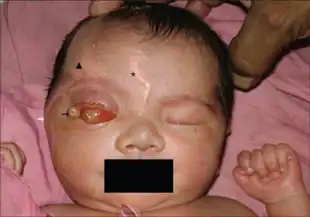Encephalocraniocutaneous lipomatosis
| Encephalocraniocutaneous lipomatosis | |
|---|---|
| Other names: Haberland syndrome,[1] | |
| Specialty | Neurology |
Encephalocraniocutaneous lipomatosis (ECCL), is a rare condition primarily affecting the brain, eyes, and skin of the head and face.[2] It is characterized by unilateral subcutaneous and intracranial lipomas, alopecia, unilateral porencephalic cysts, epibulbar choristoma and other ophthalmic abnormalities.
It was named after Haberland and Perou who first described it.[3]
Signs and Symptoms

Eighty to ninety percent of those with encephalocraniocutaneous lipomatosis are unable to produce and keep fat tissue and have multiple lipomas.[4] Other types of growths, including jaw tumours, may also occour.
Approximately two thirds of individuals with Encephalocraniocutaneous lipomatosis have intracranial and/or intraspinal lipomas. They also have an increased risk of developing a form of brain cancer known as a glioma. Other neurological issues that can occour include seizures, spasticity and variable intellectual disability. However, approximately one third of effected individuals have typical intelligence.
The most common ocular abnormality in encephalocraniocutaneous lipomatosis is a form of benign growth called a choristoma which can occour in one or both eyes. These may effect vision.[5] Other ocular symptoms include abnormally small eyes, small pupils, iris hypoplasia, sclerocornea, hypertrophic conjunctivae, an absent macular reflex and anterior chamber anomalies. There may be eyelid colobomas and short or abnormal palpebral fissures.[6] Skin tags often grow around the eyelids.[5]
Cause
Encephalocraniocutaneous lipomatosis results due to mutations in the FGFR1 gene, which helps make fibroblast growth factor receptor 1[5]
Diagnosis
In terms of the diagnosis for this condition the clinical presentation and imaging of the affected individual lead to a identification of Encephalocraniocutaneous lipomatosis [7]
History
This condition was first described in 1970.
See also
References
- ↑ Koishi, Giovanna Negrisoli; Yoshida, Mauricio; Alonso, Nivaldo; Matushita, Hamilton; Goldenberg, Dov (2008). "Encephalocraniocutaneous lipomatosis (haberland's syndrome): a case report of a neurocutaneous syndrome and a review of the literature". Clinics. 63 (3): 406–408. doi:10.1590/S1807-59322008000300020. PMC 2664244. PMID 18568254.
- ↑ Reference, Genetics Home. "ECCL". Genetics Home Reference. Archived from the original on 22 September 2017. Retrieved 22 September 2017.
- ↑ Haberland, C; Perou, M (February 1970). "Encephalocraniocutaneous lipomatosis. A new example of ectomesodermal dysgenesis". Archives of Neurology. 22 (2): 144–55. doi:10.1001/archneur.1970.00480200050005. ISSN 0003-9942. PMID 4902772.
- ↑ "Encephalocraniocutaneous lipomatosis". National Organisation for Rare Disorders. Archived from the original on March 18, 2021. Retrieved July 7, 2021.
- 1 2 3 "Encephalocraniocutaneous lipomatosis". MedlinePlus. Archived from the original on March 20, 2021. Retrieved July 7, 2021.
- ↑ "ENCEPHALOCRANIOCUTANEOUS LIPOMATOSIS;ECCL". Online Mendelian Inheritance in Man. Archived from the original on March 28, 2021. Retrieved July 7, 2021.
- ↑ Chandravanshi, Shivcharan L. (May 2014). "Encephalocraniocutaneous lipomatosis: A case report and review of the literature". Indian Journal of Ophthalmology. 62 (5): 622–627. doi:10.4103/0301-4738.133521. ISSN 0301-4738. Archived from the original on 28 August 2021. Retrieved 31 July 2021.
External links
| Classification | |
|---|---|
| External resources |
|